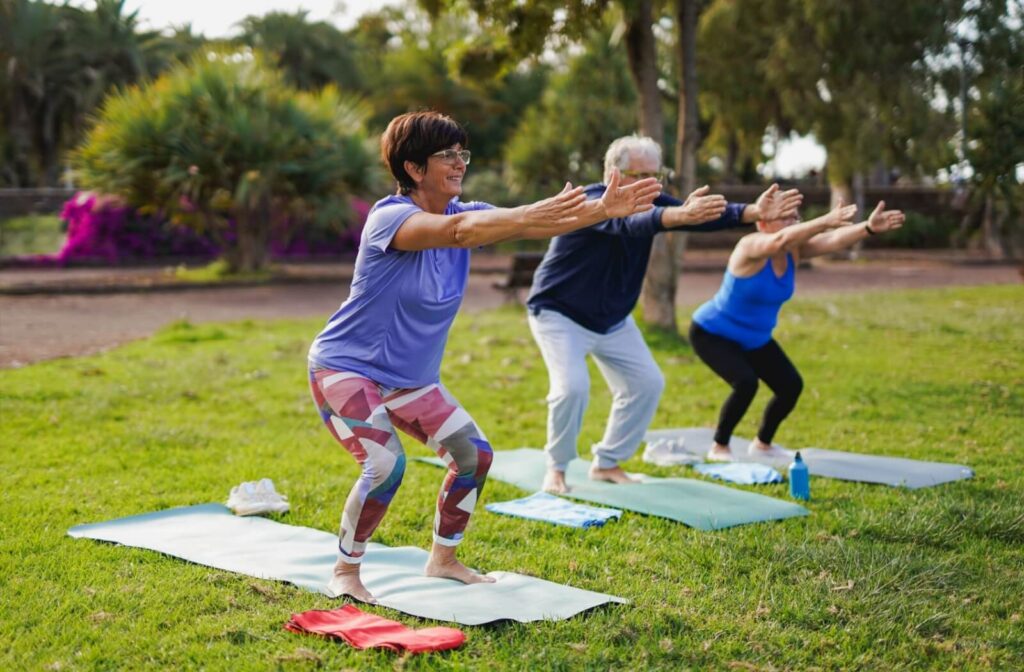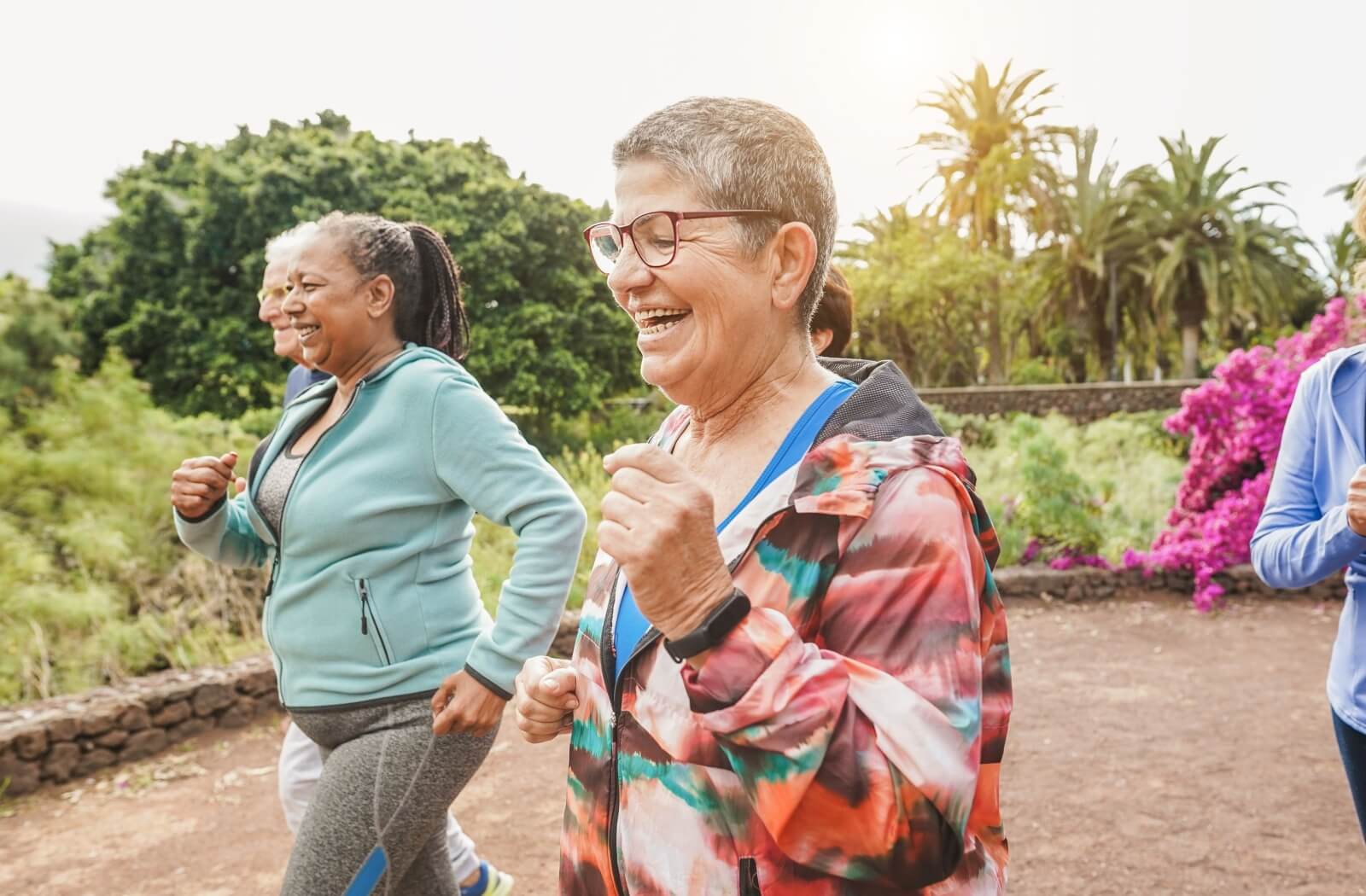Aging doesn’t have to mean retreating from the world—it can be a time to embrace new opportunities for growth, connection, and joy. Seniors today are leading longer, healthier lives, and many are choosing to stay engaged in ways that support their well-being on all fronts.
It’s a mentality known as active aging. It focuses on maximizing quality of life as we grow older.
With an emphasis on physical activity, social interaction, emotional well-being, and mental stimulation, active aging enables older adults to lead more fulfilling and independent lives while staying connected to what brings them purpose.
What Is Active Aging?
Active aging is a holistic approach to growing older, centered on the idea that people can continue to thrive through participation, wellness, and independence.
The World Health Organization defined it as the process of optimizing health, participation, and security in older age.
The approach doesn’t just aim to extend lifespan—it enhances day-to-day life by helping seniors stay involved in meaningful activities, strengthen their bodies and minds, and remain connected to their communities.
Why Active Aging Matters
Embracing active aging is a choice to live intentionally. When seniors remain physically active, socially connected, and mentally engaged, they tend to enjoy improved physical health, emotional stability, and cognitive function.
It’s also about cultivating purpose—whether that means setting personal goals, nurturing relationships, or exploring hobbies. Active aging enables older adults to maintain dignity, autonomy, and a sense of vibrancy in their everyday lives.
The Benefits of Active Aging
Active aging affects all areas of wellness. From improved mobility to deeper social bonds, the benefits of staying active extend well beyond physical health.
Physical Health
Maintaining physical activity is one of the most effective ways to support independence and mobility. Seniors who move their bodies daily enjoy stronger muscles, improved balance, and reduced risk of injury or chronic disease.
Even simple movements—such as stretching, walking, or light resistance training—can lead to more restful sleep, improved cardiovascular health, stronger bones, and increased energy throughout the day.
Mental & Cognitive Resilience
An active mind is just as crucial as an active body for healthy aging. Mental engagement improves focus, memory, and problem-solving skills while reducing the risk of cognitive decline.
Activities like word puzzles, reading, or learning something new give the brain a workout and support lifelong learning. These experiences help seniors stay sharp and curious about the world around them.
Emotional Wellness
Emotional well-being is crucial for maintaining resilience and experiencing joy later in life. Active aging encourages seniors to pursue fulfilling goals, stay connected to their passions, and make time for self-care.
Whether it’s expressing creativity, engaging in mindfulness, or building routines that foster peace and accomplishment, nurturing emotional health creates a strong foundation for aging well.
Social Connection
Human connection plays a vital role in overall health. Seniors who engage socially tend to experience less loneliness and depression and more overall satisfaction with life.
Whether chatting with friends, participating in group activities, or attending local events, meaningful interactions provide support, purpose, and a deeper sense of belonging.
Fueling the Body & Mind with Nutrition
What we eat affects how we feel—physically, mentally, and emotionally. For seniors, balanced nutrition provides the fuel needed to maintain strength, clarity, and immune health.
Nutritious Eats for an Active Lifestyle
Eating well is about more than satisfying hunger—it’s a foundation for strength, focus, and resilience as we age. When seniors prioritize wholesome, nourishing meals, they’re equipped to stay active, mentally alert, and emotionally balanced.
The right foods can help stabilize blood sugar levels, reduce inflammation, and promote long-term health. A thoughtful approach to nutrition means choosing foods that are rich in nutrients, easy to prepare, and enjoyable to eat.
To build a balanced plate, try focusing on:
- Colourful fruits & vegetables, like beets, zucchini, blueberries, & kale, offer essential vitamins & antioxidants that support cellular health & protect against disease
- Protein variety, rotating protein sources such as salmon, lentils, eggs, or low-fat dairy, to maintain muscle tone & aid recovery after physical activity
- Complex carbohydrates, swapping white bread or pasta with fiber-rich grains like farro, bulgur, or steel-cut oats to support digestion & maintain steady energy levels
Above all, mealtime can be a joyful ritual—an opportunity to slow down, nourish your body, and connect with others.
Easy Tips for Building Healthy Eating Habits
Incorporating small, intentional choices into your daily routine can support long-term well-being and make mealtime enjoyable again.
- Plan & prep
- Prepare ingredients or meals in advance so healthy choices are easier during the week
- Use the plate method
- Fill half your plate with vegetables, one-quarter with lean protein, & one-quarter with whole grains
- Snack smart
- Choose healthy snacks like yogurt, almonds, sliced veggies, or fresh fruit instead of processed options
- Limit added sugars & sodium
- Read labels & research so you can understand the portions; cook at home when possible to manage hidden ingredients
- Hydrate regularly
- Sip water throughout the day, & consider adding herbal teas, broths, or water-rich foods like cucumbers & oranges to your diet
These small shifts can help seniors feel more energized, clear-headed, and ready to embrace an active lifestyle—one meal at a time.
Rediscovering Joy Through Hobbies & Interests
One of the most rewarding aspects of active aging is the opportunity to explore—or rediscover—hobbies and creative passions. These activities offer a sense of purpose, structure, and fun.
Meaningful Activities to Try
From crafting and journaling to gardening and tai chi, hobbies help seniors stay mentally engaged and emotionally fulfilled. These pursuits not only provide enjoyment but also foster cognitive stimulation and social interaction.
Even learning a new skill, like photography or music, can open the door to fresh excitement and confidence in daily life.

How to Start Living Actively
Adopting an active aging lifestyle doesn’t require major changes all at once. The key is to begin with intention, embrace progress over perfection, and stay open to what brings you joy and energy.
Simple Ways to Begin
Active aging isn’t about doing everything at once—it’s about showing up for yourself, day by day, with curiosity and care.
Ease Into It
Choose one new habit or activity and stick with it. A short daily walk, a weekly class, or even 5 minutes of stretching can build momentum.
Get Involved
Surround yourself with others who inspire and support you. Whether it’s a walking group, a local workshop, or a community center, connection fuels consistency.
Give Your Time
Volunteering offers purpose, structure, and the satisfaction of helping others. Even a few hours a month can lift your spirits and strengthen social ties.
Nurture Your Well-Being
Self-care is more than a buzzword—it’s essential. Focus on quality sleep, mental rest, and calming routines that help reduce stress and recharge your energy.
Acknowledge Your Wins
Every small step matters. Celebrate moments of effort and growth, and allow yourself to feel proud of the progress you’re making.
A Place That Supports Active Aging
Having the right environment can make all the difference. Communities that foster movement, learning, and connection help older adults thrive with purpose and joy.
At All American Assisted Living at Wrentham, active aging isn’t just encouraged—it’s built into daily life. With thoughtfully designed programs, engaging activities, and a supportive atmosphere, our residents enjoy opportunities to stay physically active, mentally sharp, emotionally balanced, and socially connected.
Schedule a tour today and discover how our community fosters independence, well-being, and meaningful living at every stage.





